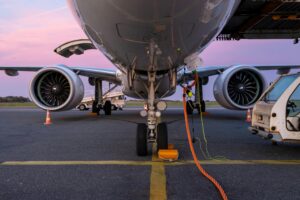Why Nigerian Aviation Struggles to Attract Investment and Modern Aircraft
In the fiercely competitive global aviation industry, where capital and modern aircraft are allocated to markets offering stability and returns, Nigeria—a nation brimming with economic potential—remains “at the back of the queue,” as global professionals often describe it. Despite its strategic location, burgeoning population, and role as West Africa’s gateway, Nigeria’s aviation sector struggles to attract investment and secure newer, fuel-efficient aircraft under favorable leasing terms. Low aircraft utilization, coupled with systemic, regulatory, and economic barriers, keeps Nigerian carriers grounded while competitors soar. This article explores the root causes of Nigeria’s challenges and charts a path to reposition its aviation sector for growth.
A Market of Untapped Potential
Nigeria’s aviation sector is a study in contrasts. With over 200 million people and one of Africa’s largest GDPs, the country should be a magnet for aviation investment. Cities like Lagos, Abuja, and Port Harcourt drive significant demand for air travel, yet the sector contributes only 1.7 billion dollars to Nigeria’s economy—a fraction of its potential. The International Air Transport Association (IATA) forecasts global air traffic growth of 3.4% annually through 2040, with Africa outpacing this rate. Nigeria, with its underserved regional routes, is ideally positioned to capitalize on this trend. However, Nigerian airlines face high leasing costs, reliance on outdated aircraft, and low profitability, leaving them unable to compete for capital or modern fleets.
Globally, the aviation leasing market thrives, with newer aircraft offering stable returns and low risk. Yet, Nigerian carriers often resort to costly wet leases—where lessors provide crew, maintenance, and insurance—or operate aging aircraft, both of which erode margins. Low aircraft utilization further compounds these challenges, reducing revenue and undermining the ability to meet lease obligations. Why does Nigeria, despite its promise, remain sidelined?
Systemic Barriers to Investment
1. Low Aircraft Utilization and Profitability
Nigerian airlines suffer from chronically low aircraft utilization, with many aircraft flying fewer than 8 hours daily compared to the global average of 10-12 hours for efficient carriers. This underutilization stems from operational inefficiencies, such as frequent delays due to poor airport infrastructure, limited route networks, and regulatory bottlenecks. Low utilization directly reduces revenue, as aircraft generate income only when airborne. For airlines operating on thin margins, this translates to an inability to cover high lease payments, maintenance costs, and fuel expenses, making them less creditworthy to global lessors. The resulting financial strain discourages investment, as lessors prioritize markets where airlines can maximize aircraft usage and ensure timely payments.
2. Regulatory Uncertainty and Lack of Trust
Regulatory inconsistency further undermines Nigeria’s appeal. Global lessors and financiers favor markets with enforceable contracts and straightforward asset repossession. Nigeria’s partial compliance with the Cape Town Convention, which governs aircraft leasing and repossession, has improved to a 75.5% score, but past breaches of lease agreements have left a lingering distrust. Foreign investors, as noted by Aviation Minister Festus Keyamo, lack confidence in Nigeria’s judiciary and policy reliability. The stalled 2015 aviation roadmap, which promised a national carrier and airport concessions, exemplifies this inconsistency, pushing Nigeria behind competitors with predictable regulatory environments.
3. Foreign Exchange Volatility
Nigeria’s foreign exchange (FX) crisis is a major barrier. Airlines require foreign currency for leasing, maintenance, and spare parts, but Nigeria’s volatile FX market and tight exchange controls create uncertainty. Trapped revenues—over $600 million for foreign airlines in recent years—have led carriers to exit Nigeria. Local airlines, forced to source FX on the open market, often miss lease payments, further damaging their reputation with lessors. This financial instability makes favorable dry leases elusive, forcing reliance on expensive wet leases.
4. Infrastructure and Maintenance Gaps
Nigeria’s aviation infrastructure is woefully inadequate. Airports lack modern check-in systems, baggage handling, and reliable fuel services, contributing to delays that reduce aircraft utilization. The absence of a robust Maintenance, Repair, and Overhaul (MRO) facility forces airlines to spend billions abroad, with Aero Contractors’ limited capacity unable to meet demand. Nigeria’s fleet, with 69.2% of aircraft deemed unserviceable, relies heavily on outdated, fuel-intensive planes, increasing operating costs and insurance premiums while deterring investment in newer models.
5. Human Capital Shortages
A shortage of skilled pilots, engineers, and air traffic controllers limits operational efficiency and scalability. While the Nigerian College of Aviation Technology (NCAT) is a step forward, its capacity cannot meet industry needs. This reliance on foreign expertise raises costs and signals a lack of self-sufficiency to investors, who prioritize markets with robust human capital ecosystems.
The Global Competitive Landscape
Nigeria competes with aviation hubs like Ethiopia and the UAE, which have leveraged consistent policies and modern infrastructure to attract capital. Ethiopian Airlines, for instance, operates a cutting-edge MRO facility and benefits from government-backed financing, enabling it to secure favorable leases and expand its fleet. Nigeria’s failure to establish a national carrier or aviation leasing company, combined with its operational and economic challenges, leaves it struggling to compete. Low aircraft utilization, in particular, signals to lessors that Nigerian carriers cannot generate the revenue needed to justify investment in modern aircraft.
A Path Forward: Strategic Reforms for Nigerian Aviation
To move to the front of the queue, Nigeria must address its structural challenges with urgency and coordination:
1. Boost Aircraft Utilization
Improving operational efficiency is critical. Upgrading airport infrastructure, streamlining air traffic control, and expanding regional routes would increase daily flight hours, boosting revenue and creditworthiness. Public-private partnerships could fund these improvements, making Nigerian airlines more attractive to lessors.
2. Strengthen Regulatory Frameworks
Full compliance with the Cape Town Convention, including reliable judicial processes for repossession, is essential to rebuild trust. Consistent policy implementation, building on recent insurance reforms, will signal stability to investors.
3. Establish a National Aviation Leasing Company
A domestic leasing entity would reduce reliance on costly foreign leases and stabilize FX demands. Modeled on successful African carriers, this could attract foreign investment while retaining local control.
4. Invest in Infrastructure and MRO
Modernizing airports and establishing a world-class MRO facility in Lagos or Abuja would enhance efficiency and reduce costs. Partnerships with U.S. firms, dominant in Nigeria’s aircraft market, could accelerate progress.
5. Address FX Challenges
A dedicated FX window for aviation, as proposed by Minister Keyamo, would ensure timely payments to lessors, improving access to favorable leases.
6. Enhance Human Capital
Expanding NCAT’s capacity and incentivizing private-sector training will address skill shortages, reducing reliance on foreign expertise and boosting investor confidence.
Soaring to New Heights
Nigeria’s aviation sector is at a pivotal moment. Its strategic position and growing demand present a compelling case for investment, but low aircraft utilization, regulatory uncertainty, FX volatility, and infrastructure deficits keep it grounded. By addressing these challenges through bold reforms, Nigeria can unlock its potential as West Africa’s aviation hub. The skies are calling—Nigeria must act decisively to secure the capital and aircraft needed to compete globally.
Disclaimer: The insights shared in this article are for informational purposes only and do not constitute strategic advice. Aviation markets and circumstances vary, and decisions should be based on your organization’s specific context. For tailored consultancy and guidance, please contact info@avaerocapital.com.




